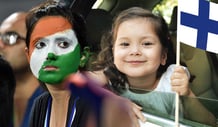
The Taliban is trying to convince the population that it has changed its approach, asserting that its policy will be less strict than its previous rule of the country, while it has not been confirmed whether it will engage in negotiations that include all local, political, ethnic and religious forces.
Afghanistan’s ethnic diversity has been at the center of the country’s politics and conflict for more than a century, and these divisions are expected to play a role in the Taliban’s formation of a new government.
No ethnic group represents a decisive majority among Afghanistan’s 40 million people, making divisions a permanent challenge to political stability, according to AFP.
Last year, Afghanistan ranked fourth as the most dangerous country in the world in the Endangered Peoples Index prepared by the International Minority Rights Group and stated that all ethnic groups in it face the risk of systematic violent persecution and mass killing.
The following is a brief overview of the main ethnic groups in Afghanistan.
Pashtuns
The Pashtuns are the largest ethnic group in Afghanistan, making up more than 42 percent of the population.
This predominantly Sunni Pashto-speaking group has dominated Afghan political institutions since the 18th century.
Over the years, many Pashtun leaders have stressed the “entitlement to rule” Afghanistan, angering other ethnic groups.
Most of those belonging to the Taliban movement, which took control of Afghanistan for the second time after its rule from 1996 to 2001, are Pashtuns.
Even the two presidents under previous governments, Hamid Karzai and Ashraf Ghani, are ethnic Pashtuns.
The dominance of the Pashtuns, traditionally centered in the south and east of the country, has angered other ethnic groups, especially because of their political, economic and cultural marginalization.
Tajik
Tajiks are the second-largest ethnic group in Afghanistan and make up more than a quarter of the population.
The main language used by the Tajiks is a branch of the Persian language called Dari, which is also a lingua franca in Afghanistan.
The group is distributed mainly in the north and west of the country and has strongholds in the Panjshir Valley, Herat city (west), and some northern states.
The Panjshir Valley is famous for its resistance to not only the Soviet occupation in the 1980s but also the former Taliban regime.
Although not politically dominant, a number of prominent Tajik leaders have emerged in recent decades.
The late commander Ahmed Shah Massoud, who bore the title “The Lion of Panshir” and fought the Red Army and the Taliban, tops the list among Afghans.
Also on the list is Burhanuddin Rabbani, a Tajik from Badakhshan province in the north of the country, who served as president between 1992 and 1996 before Kabul fell to the Taliban.
Abdullah Abdullah, the former chief executive and chief peace negotiator for the former Afghan regime is mixed ethnically, Pashtun-Tajik, but is widely seen as Tajik.
Hazara
The Hazara ethnicity, which is believed to have origins among the peoples of Central Asia and the Turkic peoples, makes up about 10 percent of the population and is concentrated mainly in central Afghanistan.
She speaks the Dari dialect, and the majority are Shiite Muslims.
This group has faced violent persecution and discrimination in Afghanistan on the basis of religion and ethnicity for more than a century.
And massacres have been carried out against them under various Afghan governments in recent decades, but especially under the rule of the Taliban.
Other militants in Afghanistan, such as the Islamic State, have also targeted Hazaras with deadly bomb attacks, not even providing their schools and hospitals.
Uzbeks
The Afghan Uzbek ethnicity also makes up about 10 percent of the population and is concentrated mainly in the north of the country near the border with Uzbekistan.
This ethnicity, which is one of the Turkic-speaking peoples, is mostly Sunni Muslims.
Among the most famous Afghan Uzbeks, the warlord Abdul Rashid Dostum, who fought with the Soviets against the Mujahideen before changing allegiance and establishing his own stronghold in the city of Mazar-i-Sharif in the north of the country.
He was a prominent figure in the Northern Alliance that helped end Taliban rule after the US invasion in 2001, and later joined the Ghani administration as first vice president.
He fled to Uzbekistan when Mazar-i-Sharif fell to the Taliban this August.
Smaller ethnic groups
The 2004 Afghan constitution officially recognized more than a dozen ethnic groups. In addition to the four major groups, the nomadic peoples of the Imaq, the Turkmen, and the Baluch are also included.
It also included the Nuristanis in northeastern Afghanistan who were forced to convert to Islam in the 19th century.
Since entering Kabul on August 15, the Taliban’s attempts to reassure themselves have not stopped the flow of thousands of Afghan citizens without an influx to leave the country, unconvinced by these promises.











